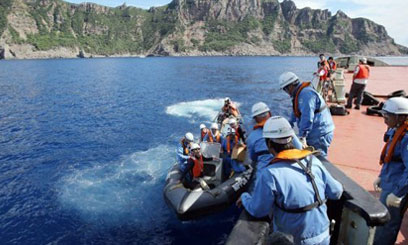Decades-long speculation about the value of the islands, known in Japan as Senkaku and as Diaoyu in China, have been based largely on an obscure 1969 United Nations report suggesting the seabed in the area could contain an oil bonanza.
But the document, produced from surveys conducted by an international team of experts, including scientists from China and Japan, never gave any estimate of the reserves and said more research was needed.
“Sediments beneath the continental shelf… are believed to have great potential as oil and gas reservoirs,” says the report.
“An area several times larger than Taiwan lies north of that island with sediment thicknesses exceeding two kilometres (1.2 miles) and perhaps reaching the nine kilometre thickness that underlies Taiwan.”
The islands lie some 200 kilometres from Taiwan.
This sediment is of a similar age and structure to the strata under Taiwan that are known to contain oil, the report says.
“The shallow sea floor between Japan and Taiwan appears to have great promise as a future oil province of the world, but detailed seismic studies are now required. Afterward, the final test must be made by offshore drilling.”
The mere suggestion of vast reserves — and media speculation in the 1970s that the continental shelf between Taiwan and Japan could hold a staggering 100 billion barrels of oil — was enough to set off a territorial scramble.
“We don’t believe such a huge amount is actually there,” a Japanese official, who spoke on condition of anonymity, told AFP.
More recent investigations have not focused on the islands in particular.
A 1994 Japanese report said maximum reserves on the whole of the Japanese side of the median line of the East China Sea — the midpoint as Tokyo sees it — stood at 3.26 billion barrels.
However, Japan’s agency for natural resources and the foreign ministry insist there is little reliable data concerning energy reserves around the islands, which are also situated in rich fishing grounds.
“That was an estimate for a vast area in the East China Sea including waters around the Okinawa island chain,” the official said, referring the 1994 report.
For its part, the China National Offshore Oil Corp.’s 2011 annual report said the firm had 384.6 million barrels of proven crude oil reserves in the whole of the East China Sea and natural gas reserves of 303.7 billion cubic feet.
In 2008, Japan and China agreed to cooperate in developing the area’s natural resources, vowing to make it a “Sea of Peace, Cooperation and Friendship” pending an agreement on regional territorial claims.
But the once low-level row intensified last week when the Tokyo government bought three of the islands from their private Japanese owners, effectively nationalising them.
The Japanese-controlled islands are also claimed by China and Taiwan, and the current row has roiled relations between Beijing and Tokyo, which are coloured by Chinese resentment over past conflicts and atrocities.
Widespread demonstrations have erupted in recent days with tens thousands of anti-Japan protestors rallying Tuesday to mark the anniversary of a 1931 event which set off Japan’s invasion of a territory now part of modern day China.










































